Articles || Other || What's New || Table of Contents
America is the "Saudi Arabia" of CoalPlant fossils of West Virginia are examples of the fossil flora that comprise the vast coal reserves that are typical in the Eastern United States. Coal is formed from ancient plant material accumulating over long periods of time in swamp conditions so devoid of oxygen that bacteria could not exist to cause decay. Being composed almost entirerly of plant fossils, coal is in effect concentrated sunlight, and is one of our most important fossil fuels. The United States as a whole has more recoverable coal resources than any other country on the planet-- over 262 billion tons-- enough to last over 200 years! Long after the rest of the world's coal, petroleum and natural gas reserves have run out, America will still have enough coal to satisfy its energy needs.
Because coal is found in 34 of the 50 United States, it can be mined and delivered to virtually any place in the country to make electricity. Generating electricity close to where it is used minimizes power loss due to the electrical resistance on transmission lines. Coal is used to generate electricity in every U.S. state, including Hawaii.
Coal currently generates about 50% of the electricity used in the U.S., and over 98% of that coal is mined here at home. In 2008 approximately 1.17 billion tons of coal were consumed in the U.S. to produce electricity, steel, plastics, aspirin, cosmetics, asphalt, and a variety of other products. Coal is also a valuable raw material for making liquid fuels like methanol and gasoline, as the Germans were doing during World War II and like the South Africans are doing today.
The Petroleum ParadoxWhile the U.S. has ample reserves of coal, the outlook for domestic reserves of conventional oil and natural gas is a different matter. We consume more crude oil than we produce domestically. In the not too distant future the same may be true for natural gas, but there are vast reserves on unconventional gas that can be added to the energy mix, if the environmental issues associated with the long horizontal drilling and massive hydro-fracking can be resolved. If recent EIA statistics (4) are taken literally, and were the U.S. suddenly deprived of petroleum imports (currently at 64%), our domestic oil reserves could be depleted in less than 4 (90 / 24.33) years and natural gas in about 10 (245 / 24.22) years (see Figures 3 and 4). That is, unless we decrease consumption, increase prices (allowing drilling and mining in deeper or more expensive places), or both. Additionally, domestic resources of oil and natural gas could be extended by developing the U.S. continental shelf (currently off-limits) and also by developing excluded parts of the Alaskan North Slope. But starting new mines, oil fields, and power plants to meet our current and future energy needs requires lead time, and time is running out. Roadblocks to domestic fossil fuel development erected by the current federal administration-- particularly to coal-- are causing fuel prices to increase as supply falters and compliance costs escalate.
It is astonishing that the great importance of domestic coal to the U.S. energy portolio is seldom, if ever, mentioned by the news media. When it comes to energy, COAL is the greatest security blanket we have. It is our most abundant, reliable, and least expensive energy source.
To meet our projected petroleum needs, we will rely on tapping our remaining and increasingly-expensive domestic oil reserves, increasing our oil imports, or creating petroleum products using coal as a feedstock. Other energy sources like nuclear and renewables are projected to supply about 18% of our energy needs between 2010 and 2030. If it were not for coal, we would find ourselves in an energy crisis with no way out. Or else like European countries, we would end up being dependent on oil imports from the Middle East and natural gas imports from Russia for the bulk of our energy needs. The use of renewable energy, like wind and solar, is also dependent upon expansion of conventional electrical generation. More on this after a brief-- but important--comparison of energy costs.
Coal is the Key to Affordable Energy
As a point of reference, oil is sold by the barrel, coal by the ton, and natural gas by the thousand cubic feet. A way to compare these equally is on a $ per million BTU basis. BTU ( British Thermal Unit) is a standard measure of energy used throughout the energy industry. The chart at left compares the different fossil fuels using $ per million BTU, and shows that in the late 1960's and early 1970's the prices for coal, oil, and natural gas were not that different from each other. This changed in the mid 1970's with the OPEC oil embargo and continued into the early 1980's. From 1995 to the present, both crude oil and natural gas have increased in cost dramatically, relative to coal. Compared to oil and natural gas, coal prices have remained remarkably steady throughout the entire period 1968 to 2008. Two significant coal price increases occurred in the late 1970's and again between 2005 and 2008. However, even as prices doubled (only to retreat later) the effect is not obvious on this chart because relative to oil and natural gas prices, the price fluctuation of coal was comparatively insignificant! Like all energy sources, the cost of coal is likely to increase in the future, if for no other reason than coal is currently under intense assault by enviro-social activism and also currently by the federal government in a way that is truly unprecedented. Yet, the most aggressive efforts to limit coal production and artificially increase the cost of using coal are unlikely to approach the cost of using oil and natural gas. For now, and for as far as we can see into the future, crude oil is more than 10x more expensive than coal and natural gas is at nearly 4x the price of coal. America's energy future and prosperity are integrally dependent upon mining and using its most abundant, affordable, and dependable energy supply-- which is coal. As a society, Americans are generally unaware of just how important coal is to the American way of life, as the news media and education system seldom provide this information. On the other hand, extreme environmentalism is exerting a relentless push to remove coal from our national energy portfolio. "Compromise" is not even in their lexicon any longer. Meanwhile, China has seized the opportunity to position itself as the next great superpower of the world, using the power of coal to fuel their ambitious growth to industrial dominance.
China Chooses CoalRecently, China surpassed the United States as the world's largest user of coal, and they are projected to increase their coal use by 271% over the next 20 years in the form of increased coal-fired electrical generating capacity from 250 Gigawatts (Billion watts) annually in 2006 to 950 Gigawatts by 2030. China is also poised to be the second-largest developer of wind energy in the world, about 120 Gigawatts by 2030, second only to OECD Europe. Interestingly, most wind turbines made today come from China, where they are produced using General Electric technology. However, China is not relying on wind energy to power very much of their own industrial future. That-- they clearly plan to do with coal 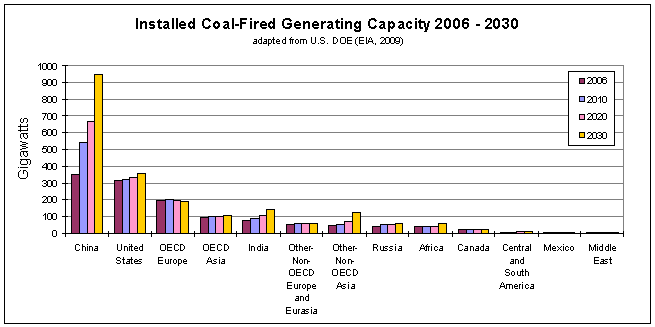 (view the numbers). Although China will be using significantly more coal than the U.S. (according to official projections), they have a lot less of it-- about 126 billion recoverable tons, compared to at least 262 billion recoverable tons in the U.S (see Figure 1). Part of the reason China is not taking advantage of their dominance in the wind energy market to satisfy their own energy needs with wind is that the combined capital, operating, and availability costs associated with wind (and solar, too) make them the most expensive energy options available. Without subsidies, wind and solar power are priced out of the marketplace. But there is another, more important reason: renewable electrical generating capacity must have built with it equal amounts of reliable generating capacity (coal, natural gas, or nuclear).
Renewable Energy Requires CoalAs surprising as it sounds, renewable energy cannot exist without coal, natural gas, or nuclear energy-- not unless we intend to ration energy or live with frequent power black-outs as part of our energy strategy. This is because for every megawatt of renewable energy capacity that is built, an equal amount of coal power (or other conventional power) must be added as back-up for the periods when the wind isn't blowing or the sun isn't shining.
Therefore, additional wind or solar generating capacity requires an equal amount of coal, gas, oil, or nuclear generating capacity, as backup. Unless power consumers are willing to pay for this redundancy, we will have to adapt to life where homes, factories, offices, and hospitals have electrical power only when the sun shines or the wind blows. Clearly, this is unacceptable, which is why conventional generating options cannot realistically be replaced. 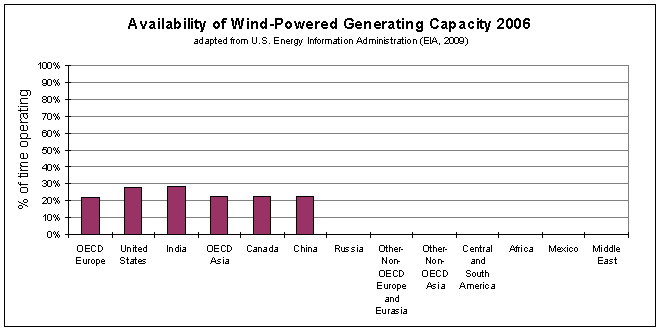 In contrast to wind energy, coal-fired power, according to EIA, has a slightly better than 70% availability. Further, the downtime of coal-fired units is usually scheduled, not forced by the weather, which is an important consideration in calculating true availability. Nuclear plants and hydroelectric plants fare even better still, with an average availability of over 80%. However, it is unlikely that we will be damming up any more U.S. rivers any time soon, nor building many new nuclear plants in the next 10-20 years. Therefore, only coal and natural gas can provide fuel for additional generating capacity to back-up renewable energy capacity and fuel economic expansion over the next 20 years. 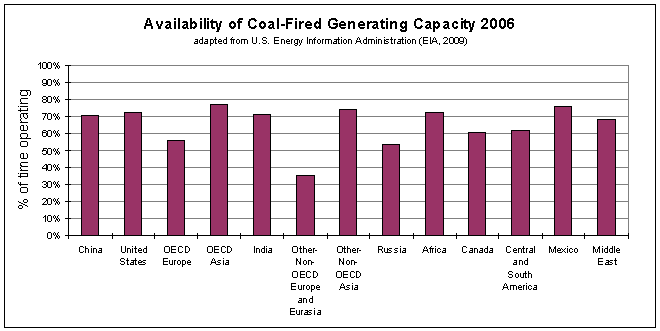 U.S. utilities have been looking at renewables for a long time, and the reason they haven't installed significant wind turbine or solar capacity already is that they cannot justify them economically, largely because of the back-up redundancy. After all, why build a new, expensive state-of-the art coal-fired generating station and just use it for a backup? It is much more cost efficient to simply put it to work on the grid full time and forget the renewables! And we do have plenty of coal. This is a reality that has many environmental groups pushing to abolish coal. Renewable energy, sadly, simply cannot be justified on a cost basis with coal-- nor can renewables provide reliable power to America without it.
If there exists a justification for wind, it is for esoteric, not economic, reasons. The U.S. simply cannot compete industrially with countries like China without coal. For example, imagine trying to supply the huge electrical demands of a commercial aluminum smelter with wind power. Even if the power were available, it would be so costly that manufacturing facilities could not survive against global competition from China and elsewhere. China has done their homework and they are making their plans to build a little bit of wind generating capacity and a whole lot of new coal-fired capacity. For a view of the projected energy consumption among the various countries and regions worldwide, see Figure 5, below. China is projected to be by far the largest consumer of power in the world-- and they will do this with coal. The U.S. will be a distant 2nd, with OECD Europe and India tied at a close 3rd. Interestingly, the U.S. is projected to remain the largest consumer of petroleum and other liquid fuels in the world, which will come mainly from imports. Too bad for us. However, coal gives us surprising options in this area as well.
Coal in Your Gas TankProbably, the best kept secret about coal, is that liquid fuels like methanol, gasoline, diesel, and jet fuel can be made directly-- and cost-competitively-- using coal conversion technology that exists today. Until oil exceeded $50 per barrel, however, it was not cost competitive.
When the price of crude oil hit $50 worldwide a few years ago, it became cheaper for the South African's to make gasoline from coal than to purchase crude oil on the open market. So far, no commercial CTL conversion plants have been built in the U.S., although the defense department has successfully converted much of their jetfuel requirements over to CTL-based sources. The cost of building a CTL plant is significant-- estimated at $5-7 billion dollars for a plant that can produce 80,000 barrels per day. Not surprisingly, China has entered into discussions with the South African's to build CTL plants like these in China.
U.S. Economy at a CrossroadsIronically, the communist nation of China is making energy decisions based on capitalist principles, while the United States of America is floundering with a non-energy policy that most closely resembles a variation of European Socialism. Europe is heavily reliant on natural gas, wind power, and nuclear power, in part because they have little coal left. With their energy supply dependent on increasingly expensive fossil fuel imports and unreliable renewables, Europe finds themselves in an uneviable position in which they cannot compete industrially without handicapping the rest of the world, particularly the U.S.
Coal is America's ace-in-the-hole in the game of global economic survival, and is our bridge to a future where technology for renewable energy or perhaps nuclear fusion can become a cost-competitive reality. America requires a viable industrial and technological capability to make this happen, which coal power can amply supply. However, increased governmental derailment of the U.S.coal industry is taking place daily at the federal level in the form of new and impossible federal regulations that restrict access to reserves and shrink coal supply and coal usage. Nature selects winners and losers through the principle of "survival of the fittest," and the same principle applies to international competition. Our remarkable coal reserves will be used, eventually, by somebody. But, if America succumbs to intensive pressure to remove coal from its energy portfolio we could find ourselves weakened economically to the point that we become a vulnerable target for those who would take our treasure of coal-- and our nation-- from us, and exploit both for themselves. Americans who value liberty and freedom, and the high standard of living that affordable, abundant energy has made possible, can do their part by voting wisely and communicating often with their elected representatives to remind them that coal mined in America-- to produce low-cost energy to power America-- promotes greater national security, reduces our trade deficit, supports high-paying jobs here at home and the financial resources to protect our environment, and gives us a fighting chance of competing in the emerging global economy. Harnessing the power of coal is looking more beautiful every day!
Created: by Monte Hieb; February 20, 2010 Last update: February 12, 2011 References: 1) U.S. Coal Reserves
by State and Mine Type, 2008; National Mining Association (NMA),. 2) Coal
Production and Number of Mines by State and Mine Type, 2008-2007; Energy
Information Administration (EIA), 2009. 3) Coal Fields of the Conterminous United States, USGS Open-File Report OF 96-92 4) International Energy Outlook; Energy Information Administration (EIA), Office of Integrated Analysis and Forecasting, U.S. Department of Energy, May, 2009 | |||||||||||||||||||||||||||||||||||||||||||||||||||||||||||||


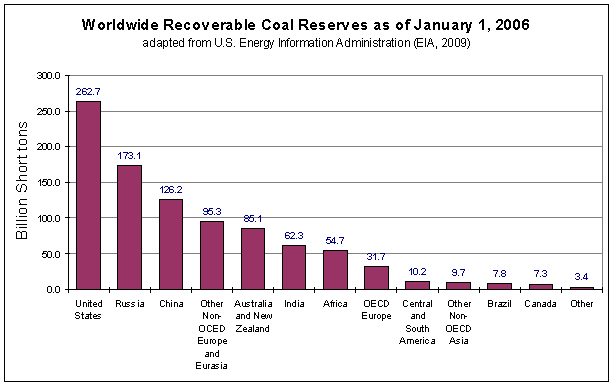
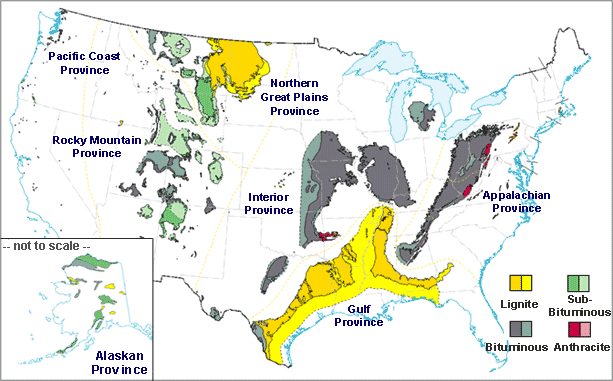
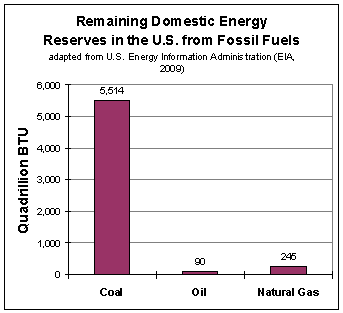
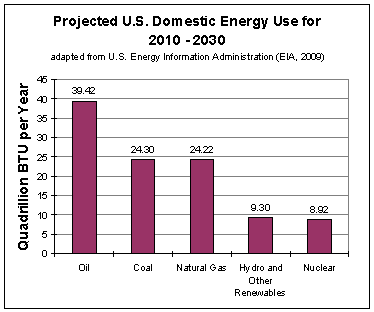
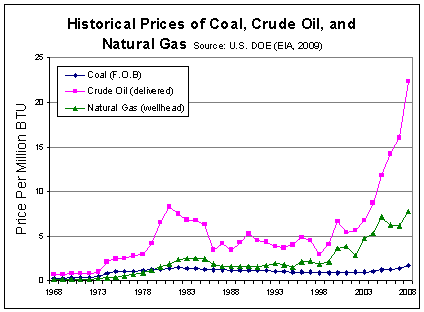 Not
only is coal something we have a lot of in the U.S., it is by far
the lowest-cost fuel, both historically and for far into the future.
Not
only is coal something we have a lot of in the U.S., it is by far
the lowest-cost fuel, both historically and for far into the future. Existing modern wind turbines have already been
built on some of the choicest sites around the world. Nonetheless, they
are unable to achieve more than 29% of their rated capacity, on average.
The reason is simply that wind is not dependable, even at the best of locations.
Also, some of the windiest places on earth are also some of the coldest
in the winter-- which has
Existing modern wind turbines have already been
built on some of the choicest sites around the world. Nonetheless, they
are unable to achieve more than 29% of their rated capacity, on average.
The reason is simply that wind is not dependable, even at the best of locations.
Also, some of the windiest places on earth are also some of the coldest
in the winter-- which has 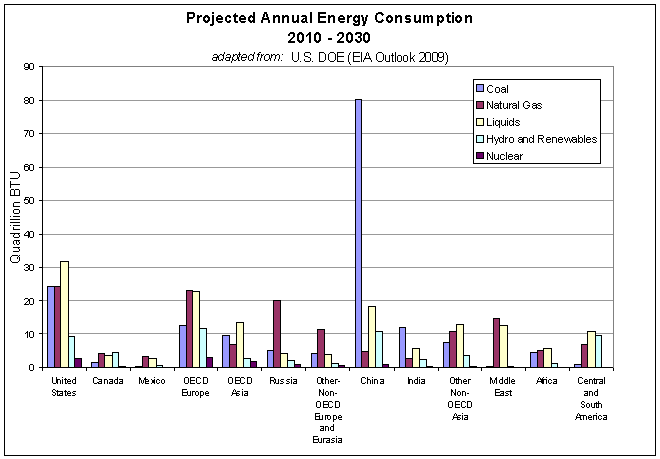
 South Africa picked up the technology in the
1950's, having a lot of low-quality coal but few crude oil reserves. They
set up a state-owned company to make crude oil from coal and further refined
the "Fischer-Tropsch" Process, as it came to be called. Coal-to-liquids
(CTL) took off when the oil shocks of the 1970's occurred, resulting in
two large plants being built, which today produce 150,000 barrels per
day of crude oil from 120,000 tons of coal..
South Africa picked up the technology in the
1950's, having a lot of low-quality coal but few crude oil reserves. They
set up a state-owned company to make crude oil from coal and further refined
the "Fischer-Tropsch" Process, as it came to be called. Coal-to-liquids
(CTL) took off when the oil shocks of the 1970's occurred, resulting in
two large plants being built, which today produce 150,000 barrels per
day of crude oil from 120,000 tons of coal.. Coal provides cheap electricity for the economic
leverage necessary for the U.S. to support labor rates and environmental
complicance costs that are higher than most anywhere else on the planet,
giving us a clean environment and standard of living that are unrivaled
in the industrialized world. Without this leverage, the loss of U.S. manufacturing
jobs will accelerate, as the rest of the world-- particular China-- assumes
the competitive advantage.
Coal provides cheap electricity for the economic
leverage necessary for the U.S. to support labor rates and environmental
complicance costs that are higher than most anywhere else on the planet,
giving us a clean environment and standard of living that are unrivaled
in the industrialized world. Without this leverage, the loss of U.S. manufacturing
jobs will accelerate, as the rest of the world-- particular China-- assumes
the competitive advantage.